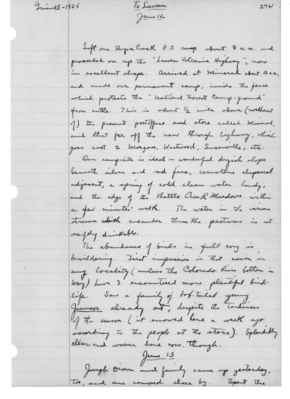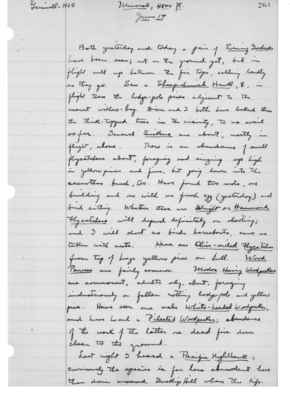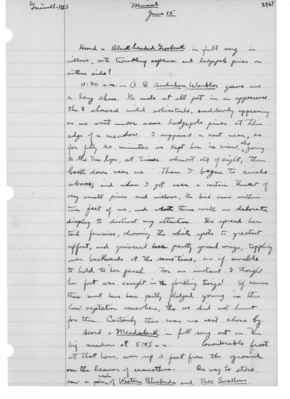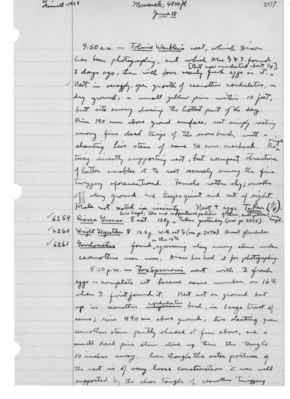Pages That Mention ceanothus
1925: Joseph Grinnell's field notes
S2 Page 5
Collector: Grinnell - 1925 Location: Lassen Section Date: June 12-13, 1925 Page Number: 2461
Left our Payne Creek P.O. camp about 8 a.m. and proceeded on up the "Lassen Volcanic Highway", now in excellent shape. Arrived at Mineral about 10 a.m., and made our permanent camp, inside the fence which protects the "National Forest Camp-ground" from cattle. This is about 1/2 mile above (northeast of) the present postoffice and store called Mineral, and that far off the new thorough highway, which goes east to Morgan, Westwood, Susanville, etc. Our campsite is ideal - wonderful dryish slope beneath silver and red firs, ceanothus chaparral adjacent, a spring of cold clean water handy, and the edge of the Battle Creek Meadows within a few minutes' walk. The water in the various streams which meander thru the pastures is not safely drinkable. The abundance of birds in full song is bewildering. First impression is that never in any locality (unless the Colorado River bottom in May) have I encountered more plentiful bird life. Saw a family of bob-tailed young Juncos already out, despite the tardiness of the season (it snowed here a week ago according to the people at the store). Splendidly clean and warm here now, though. June 13, 1925. Joseph Dixon and family came up yesterday, too, and are camped close by. Spent the
S2 Page 7
Collector: Grinnell - 1925 Location: Lassen Section (Mineral) Date: June 14, 1925 Page Number: 2463
Both yesterday and today a pair of Evening Grosbeaks have been seen; not on the ground yet, but in flight well up between the fir tops, calling loudly as they go. Saw a Sharp-shinned Hawk, female, in flight thru the lodge-pole pines adjacent to the nearest willow-bog. Dixon and I both have looked thru the thick-topped trees in the vicinity, to no avail so far. Several Siskins are about, mostly in flight, above. There is an abundance of small flycatchers about, foraging and singing up high in yellow pines and firs, but going down into the ceanothus bush, too. Have found two nests, one building and one with one fresh egg (yesterday) and bird sitting. Whether these are Wright or Hammond Flycatchers will depend definitely on shooting; and I will shoot no birds hereabouts, save any (?) taken with nests. Hear one Olive-sided Flycatcher from top of huge yellow pine on hill. Wood Pewees are fairly common. Modoc Hairy Woodpeckers are commonest, adults only, about, foraging industriously on fallen rotting lodge-pole and yellow pine. Have seen one male White-headed Woodpecker, and have heard a Pileated Woodpecker; abundance of the work of the latter on dead firs down clean to the ground. Last night I heard a Pacific Nighthawk; curiously this species is far less abundant here than down around Inskip Hill where the life-
S2 Page 11
Collector: Grinnell - 1925 Location: Lassen Section (Mineral) Date: June 15, 1925 Page Number: 2467
Heard a Black-headed Grosbeak in full song in willows, with twinkling aspens and lodgepole pines on either side! 11:30 a.m. - A female Audubon Warbler gave us a long chase. No male at all put in an appearance. The female showed wild solicitude, suddenly appearing as we went under some lodgepole pines at the edge of a meadow. I supposed a nest near, so for fully 20 minutes we kept her in view, she going to the tree tops, at times almost out of sight, then back down near us. Then I began to circle about; and when I got near a certain thicket of very small pines and willows, the bird came within ten feet of me, and went thru with an elaborate display to distract my attention. She spread her tail fanwise, showing the white spots to greatest effect, and quivered her partly spread wings, topping over backwards at the same time, as if unable to hold to her perch. For an instant I thought her foot was caught in the forking twigs! Of course there must have been partly fledged young in the low vegetation somewhere, tho we did not hunt for them. Certainly there was no nest close by. Heard a Meadowlark in full song out on the big meadow at 5:45 a.m. Considerable frost at that hour, even up 3 feet from the ground on the leaves of ceanothus. On way to store saw a pair each of Western Bluebirds and Tree Swallows.
S2 Page 13
Collector: Grinnell - 1925 Location: Lassen Section (Mineral) Date: June 16, 1925 Page Number: 2469
feeding about our campsite. The male has frequently sung from a young fir tip scarcely ten feet directly above the nest, also from the brush all about it, and when hopping on the ground between or thru the bushes. The rim of the nest is 360 mm. above a mat of yellow pine needles; the nest itself is ensconced among the leaning stems of a rather sparse ceanothus integerrimus. It is a large structure, of much coarse pine and other twigs externally, and lined with shredded bark. There are two young, about 3 days old I think, helpless and downy rather than feathery. The old female is very solicitous, coming within 6 feet of us when at the nest; but the male shows little concern, and sings volubly immediately we leave, from within 20 feet of the nest. Mountain Chickadee's nest, with young, in woodpecker hole opening on under side of a leaning stub a foot in diameter and some 15 feet long. Entrance just my height from the ground - 5 ft., 7 in.; diameter of entrance, 44 mm. - so probably was made by a White-headed Woodpecker. Site open, surrounded by dry ceanothus slope; some very small yellow pines nearby, also two yellow pine stumps, sawed off so long ago they are rotting, cleft. The old chickadees come with food freely, altho I am only about 15 feet away under a bush on the dry (?) hill side. Each bird dives directly into the hole, as it arrives,
S2 Page 22
Collector: Grinnell-1925 Location: Mineral, 4800 ft. Date: June 18, 1925 Page Number: 2477
9:50 am -- Tolmie Warbler's nest, which Dixon has been photographing, and which Mrs. G & I found 3 days ago, then with four nearly fresh eggs in it. ^[But now incubated about 1/4.] Nest in scraggly, open growth of ceanothus cordulatus, in dry ground, a small yellow pine within 10 feet, but site sunny during the hottest part of the day. Rim 190 mm. above ground surface, nest snugly resting among five dead twigs of the snow birch, with a slanting live stem of same 80 mm. overhead. No single twig directly supporting nest, but compact structure of latter enables it to rest securely among the fine twiggery aforementioned. Female rather shy; sneaks off along ground and keeps quiet and out of sight. Male not noted in vicinity. Nest & eggs taken (1/4). 6259 Sierra Grouse (male) nat. 13.8g. ^Iris hazel; toes and unfeathered portions of tarsi, dull yellow; iris hazel. Taken yesterday (see p. 2475). 6260 Wright Flycatcher (female) 12.2g. With set 1/4 (see p. 2476). Breast glandular. 6261 Gerrhonotus found ^on the 16th squirming along among stems under ceanothus near mom; Dixon has had it for photographing. 5:10 p.m. -- Fox Sparrow's nest with 3 fresh eggs -- complete set because same number on 16th when I first found it. Nest not on ground but up in ceanothus integerrimus cordulatus bush, in large tract of same; rim 490 mm. above ground; two slanting green ceanothus stems partly shaded it from above, and a small dead pine stem stood up thru the tangle 10 inches away. Even though the outer portion of the nest is of very loose construction it was well supported by the close tangle of ceanothus twiggery




